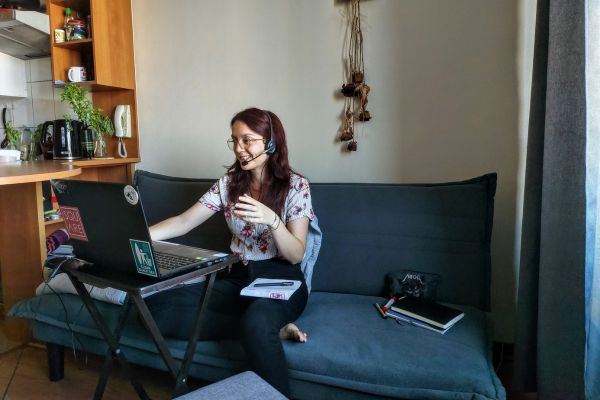Burnout is a challenge faced by many educators, and English teachers are no different. Whether you’re teaching English online, in a classroom, or balancing both, the demands of lesson planning, student engagement, and administrative tasks can take a toll on your mental and physical well-being. Left unchecked, burnout can lead to fatigue, and frustration, and even impact your ability to teach effectively.
But what exactly is teacher burnout? It’s more than just feeling tired after a long day – it’s a state of chronic stress that can manifest in emotional exhaustion, detachment, and a reduced sense of accomplishment. For English teachers, unique challenges like managing students across time zones, addressing cultural differences, and adapting to varied learning needs can amplify the risk of burnout.
The good news? Burnout is preventable. By recognizing the signs of teacher burnout early and implementing effective strategies, you can maintain your passion for teaching while safeguarding your well-being.
In this article, we’ll explore 8 essential strategies to avoid English teacher burnout. From setting boundaries to fostering a support network, these practical tips are designed to help you manage stress, stay energized, and continue making a positive impact on your students.
- 1. Set clear boundaries and stick to them
- 2. Prioritize self-care
- 3. Practice time management
- 4. Use ready-made lessons or customizable materials
- 5. Incorporate cultural contexts into lessons
- 6. Focus on work-life balance across time zones
- 7. Seek professional development opportunities
- 8. Foster a support network
- Thriving as an English teacher
1. Set clear boundaries and stick to them
One of the most effective ways to prevent English teacher burnout is by setting and maintaining clear boundaries between your work and personal life. Without boundaries, it’s easy for lesson planning, student communication, and grading to spill over into your downtime, leaving little room to recharge.
Why it matters: Teaching often comes with a sense of responsibility and a desire to support your students as much as possible. However, overextending yourself can lead to fatigue and stress, two major causes of teacher burnout.
How to set boundaries effectively:
-
Define your work hours: Set specific teaching and prep hours that align with your schedule and stick to them. For example, if you teach students across time zones, create a block of time for lessons and leave the rest of your day free for personal activities.
-
Communicate expectations: Let students or employers know when you’re available and when you’re not. Establishing clear boundaries from the start reduces misunderstandings and sets realistic expectations.
-
Learn to say no: It can be tempting to take on additional students or last-minute requests, but saying no when necessary protects your energy and ensures you can perform at your best.
By creating structure in your workday and prioritizing downtime, you’ll avoid burnout and maintain your enthusiasm for teaching.

2. Prioritize self-care
Teaching can be demanding, but you can’t pour from an empty cup. Prioritizing self-care is a critical step in preventing English teacher burnout and ensuring you have the energy to bring your best to your students. Self-care doesn’t have to be elaborate – it’s about consistently making time for the activities that recharge and nourish you, both physically and mentally.
Why it matters: Neglecting self-care can lead to stress, fatigue, and emotional exhaustion, which are common signs of teacher burnout. Taking care of yourself helps you maintain focus, build resilience, and stay passionate about teaching.
How to prioritize self-care:
-
Make time for exercise: Whether it’s a morning walk, yoga, or hitting the gym, regular physical activity reduces stress and boosts energy levels.
-
Explore guided self-care practices: Websites like Insight Timer and The Happier App offer free guided meditations, music tracks, and courses for stress relief.
-
Take breaks during the day: Step away from your desk between lessons, even if just for a few minutes, to stretch, breathe, and reset.
-
Engage in hobbies: Spend time on activities you enjoy, whether it’s reading, cooking, or listening to music. These moments of joy can refresh your mind and keep you motivated.
Remember, taking care of yourself is not a luxury, it’s a necessity. When you prioritize self-care, you’re better equipped to meet the demands of teaching while maintaining your own well-being.
3. Practice time management
Effective time management is a powerful tool for avoiding teacher burnout. With the constant demands of lesson planning, grading, and student communication, it’s easy to feel overwhelmed. By organizing your time and focusing on what matters most, you can reduce stress and maintain a healthy work-life balance.
Why it matters: Poor time management often leads to procrastination, late-night work sessions, and unnecessary stress which are all common causes of teacher burnout. A well-structured schedule allows you to work more efficiently and frees up time for rest and personal pursuits.
How to manage your time effectively:
-
Plan ahead: Dedicate a specific time each week to plan your lessons and organize your tasks. Tools like online calendars or to-do list apps can help you stay on track.
-
Batch similar tasks: Group tasks like grading assignments or replying to emails together to save time and mental energy.
-
Set priorities: Focus on high-impact activities, such as lesson delivery and student engagement, while finding ways to streamline less essential tasks.
-
Avoid perfectionism: Remember that every lesson doesn’t need to be perfect. Focus on delivering value to your students without overcomplicating your preparation process.
By managing your time wisely, you’ll reduce stress and create a sense of accomplishment, which is key to preventing burnout and staying motivated in your teaching career.

4. Use ready-made lessons or customizable materials
Lesson planning can be one of the most time-consuming aspects of teaching, and over time, it can contribute to English teacher burnout. One way to reduce this burden is by using ready-made or customizable teaching materials. These resources save time and ensure that your lessons remain engaging and effective.
Why it matters: Creating original lesson plans for every class can lead to burnout, especially when teaching a variety of students or managing tight schedules. Leveraging ready-to-use materials allows you to focus on your students’ needs without overloading yourself.
How to use pre-made materials effectively:
-
Explore trusted resources: Platforms like TEFL Lessons, Fluentize, esl.laboratory, and ESL Pals offer high-quality, ready-to-use lesson plans tailored to ESL teachers. These companies provide materials that cover diverse topics and proficiency levels, saving you time while keeping lessons engaging.
-
Adapt to your students’ needs: Use pre-made resources as a foundation and tweak them to match your students’ proficiency levels, interests, or cultural backgrounds.
-
Build a go-to library: Create a personal collection of favorite lesson plans from these platforms, organized by topic or skill area, for quick access when planning lessons.
-
Incorporate technology: Many of these companies also offer digital or interactive options, making it easy to create dynamic lessons with minimal preparation time.
By integrating ready-made materials from reliable sources, you can streamline your planning process and focus on delivering high-quality lessons.
Find the materials that will benefit your students the most with the free
ESL Teacher’s Guide to Lesson Planning Resources
download5. Incorporate cultural contexts into lessons
One of the most rewarding aspects of teaching English is the opportunity to explore different cultures while helping students improve their language skills. Incorporating cultural contexts into your lessons not only enriches the learning experience but also helps combat the monotony that can lead to English teacher burnout.
Why it matters: Repeating similar lesson structures or topics can feel tedious over time. By weaving cultural elements into your teaching, you keep lessons fresh and engaging for both you and your students, fostering a deeper connection and enthusiasm for learning.
How to integrate cultural contexts effectively:
-
Discuss traditions and customs: Use holidays, festivals, or local traditions from your students’ cultures as conversation topics or themes for lessons. For example, ask students to describe how they celebrate special occasions in their country.
-
Explore global issues: Bring in articles, videos, or discussions about global topics like environmental conservation, technological advancements, or cultural trends. These not only enhance vocabulary but also encourage critical thinking.
-
Teach idioms and expressions: Highlight idiomatic language or common expressions that reflect cultural nuances in English-speaking countries. Students often enjoy learning phrases that aren’t in textbooks, which keeps lessons lively.
-
Leverage students’ backgrounds: Encourage students to share aspects of their own cultures during lessons. This creates a collaborative learning environment and reduces the pressure on you to generate all the content.
Integrating cultural elements into your teaching enhances the learning experience, keeps lessons engaging and meaningful, and helps reduce the risk of burnout while fostering a global perspective.
Check out these 10 ESL activities to explore global holidays and traditions.
6. Focus on work-life balance across time zones
Teaching English often involves working with students from all over the world, which can mean navigating different time zones. While this global reach is exciting, it can also disrupt your schedule.
Why it matters: Constantly shifting your routine to accommodate students can lead to fatigue, irregular sleep patterns, and difficulty maintaining a healthy work-life balance. Prioritizing balance ensures you can manage your workload without sacrificing your well-being.
How to maintain work-life balance across time zones:
-
Create teaching blocks: Schedule lessons within set time frames that work for both you and your students. For instance, designate specific hours in the morning or evening for teaching and keep the rest of the day free for personal activities.
-
Set limits on availability: Communicate your teaching hours to students and avoid taking on lessons outside of those times, even if it means declining requests.
-
Plan for downtime: Make time for breaks between classes to recharge, especially if your lessons are back-to-back. Use these breaks to step away from your screen, stretch, or enjoy a quick snack.
-
Prioritize sleep: Ensure you’re getting enough rest by aligning your schedule with a consistent sleep routine. If teaching late-night or early-morning classes, plan your day to allow for naps or recovery time.
Maintaining balance across time zones doesn’t just protect your physical health, it also allows you to bring your best energy to every lesson, ensuring both you and your students benefit from a focused and engaged teaching environment.

7. Seek professional development opportunities
Teaching English is a dynamic field, and staying engaged with your profession is a powerful way to prevent burnout. By seeking professional development opportunities, you enhance your skills and reignite your passion for teaching.
Why it matters: Burnout often stems from a sense of stagnation or feeling disconnected from your career’s purpose. A few benefits of professional development are that it provides fresh ideas, new techniques, and a sense of accomplishment that can help you overcome these challenges.
How to pursue professional development:
-
Attend workshops and webinars: Explore topics like teaching methodologies, integrating technology in the classroom, or managing diverse student needs. The Bridge Expert Series webinars are an excellent resource for fresh insights and practical tips from industry experts. Check the Bridge events calendar regularly for professional development opportunities for English teachers.
-
Join teacher communities: Engage with other educators through forums, social media groups, or local meetups. Networking with peers allows you to exchange ideas and learn from their experiences.
-
Earn new credentials: Consider advanced certifications like a professional TEFL/TESOL certificate or micro-credentials in targeted areas like teaching English pronunciation, Business English, or materials development. These not only boost your expertise but also open doors to new opportunities.
-
Stay updated on trends: Follow blogs, podcasts, and professional organizations in the ESL field, or subscribe to newsletters like the Bridge Bulletin to keep up with the latest research and teaching practices. Continuous learning keeps your approach fresh and relevant.
Investing in professional development benefits your students and strengthens your confidence as an educator, ensuring a fulfilling and sustainable teaching career.
Explore strategies to get the most out of professional development.
Ready to master the terms, technology, and teaching tools used in the virtual EFL classroom?
Specialized Certification in Teaching English Online
Get Certified8. Foster a support network
Teaching English can sometimes feel isolating, especially if you’re teaching online or in a foreign country. Building a support network of fellow educators, friends, or mentors can help you navigate challenges, share ideas, and avoid the emotional exhaustion that contributes to English teacher burnout.
Why it matters: Burnout often stems from feeling unsupported or overwhelmed. Having a reliable network to lean on can provide a sense of community that keeps you motivated.
How to foster a support network:
-
Join teacher communities: Participate in online forums, Facebook groups, or LinkedIn communities where English teachers connect to share resources and advice.
-
Collaborate with colleagues: If you work at a school or within an organization, connect with fellow teachers to exchange lesson ideas or co-plan activities. Sharing the workload can ease stress and lead to more creative teaching strategies.
-
Attend networking events: Look for webinars, conferences, or workshops that include opportunities to meet other teachers. In-person events provide valuable opportunities to share ideas, gain new perspectives, and build lasting professional relationships.
-
Create your own community: Build an online community of practice or start a local meetup for teachers in your area or niche. Having regular check-ins with peers can be a great source of inspiration and camaraderie.
A strong support network reminds you that you’re not alone in facing the challenges of teaching. Together, you can overcome obstacles and thrive in your career.
Thriving as an English teacher
Burnout is a challenge that many English teachers face, but it doesn’t have to define your teaching journey. By recognizing the signs of teacher burnout and implementing these 8 essential strategies, you can protect your well-being while continuing to thrive in your career.
From setting clear boundaries and managing your time effectively to fostering a supportive network these strategies are designed to address the unique challenges English teachers encounter. Prioritizing your mental and physical health is not just beneficial for you. It also ensures you can continue making a positive impact on your students.
Remember, taking small, consistent steps to care for yourself and your career can make a big difference. Teaching is a rewarding profession. With the right tools and mindset, you can navigate its demands without losing your passion.













